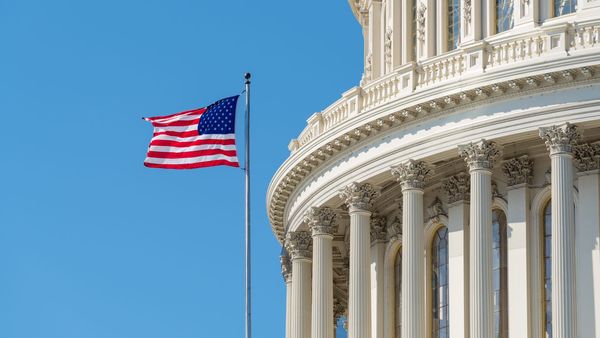The primary Federal Reserve inflation rate, the core PCE price index, showed that price pressures heated up in January, but no worse than feared, keeping a June rate cut on the table. The S&P 500 rose following the inflation data.
Primary Fed Inflation Rate
The personal consumption expenditures, or PCE, price index rose 0.3% in January, in line with forecasts. The 12-month headline inflation rate eased to 2.4%, matching estimates.
Typically, Federal Reserve decision-making puts more weight on core inflation, which strips out volatile food and energy prices. The core PCE price index rose 0.4% in January, matching forecasts. The core 12-month inflation rate eased to 2.8% vs. 2.9% in December, also in line with Wall Street expectations.
Goods prices fell 0.2% in January, while services prices rose 0.6%.
The inflation data looks a bit worse when not rounded a tenth of a percentage point. Core inflation rose 0.42% on the month. The annual increase came in at 2.849%.
On a three-month annualized basis, the Fed's primary core inflation rate picked up to 2.6% from an upwardly revised 1.6% in December. On a six-month annualized basis, core inflation ran at a 2.5% rate, up from a tame 1.9% in December.
Federal Reserve chair Jerome Powell has said policymakers wanted to see six months of tame inflation data to be sure that the disinflationary trend isn't fleeting.
January Inflation Effect?
To some extent, Wall Street has been downplaying January's jump in core prices as an aberration that doesn't really change the disinflationary trend.
The month of January, economists say, tends to see outsized price gains as companies update pricing at the start of the year, but seasonal adjustment methodology doesn't fully take that into account.
In January of 2023, the core PCE price index rose an even hotter 0.51% on the month. With January 2023 data dropping out of the 12-month calculation, the inflation rate still fell last month to 2.85% from 2.94%.
Supercore Inflation
Starting late in 2022, Federal Reserve chair Powell shifted the inflation focus to core PCE services excluding housing, or supercore services. That was in keeping with the Fed's view that the tight labor market and elevated wage growth had been at the root of stubbornly high inflation. Wages make up a high percentage of costs for service businesses. Therefore, supercore services inflation should ease as wage pressures moderate.
Prices for these core nonhousing services, including health care, haircuts and hospitality, rose 0.6% on the month, after moderate gains of 0.25% and 0.17% the prior two months. The 12-month supercore services inflation rate picked up to 3.45% from 3.3% the prior month.
Personal Income, Spending
The PCE price index is released with the Commerce Department's monthly personal income and outlays report. Personal income surged 1% on the month, way above 0.4% forecasts. Personal consumption expenditures rose a mild 0.2% in January, as predicted.
Spending on goods tumbled 1.2% in January. However, that reflects seasonal adjustments that may have been thrown off for January by Covid and a series of fiscal boosts. Meanwhile, outlays on services rose a strong 1%.
The outsized personal income gain included a 2.6% monthly increase in government subsidies, helped by a 3.2% cost-of-living increase in Social Security checks. Meanwhile, dividend income jumped 4.1% on the month.
Jobless Claims
New claims for jobless benefits rose to 215,000 in the week ending Feb. 24, up from a revised 202,000 in the prior week. The four-week average of weekly claims fell 3,000 to 215,500.
The number of unemployed workers continuing to receive benefits rose by 45,000 to 1.905 million in the week through Feb. 17.
The data, though still pretty strong, was slightly worse than expected. Some economists are expecting a significant rise in jobless claims over coming months, which would surely ease the Fed's concerns about cutting rates too soon.
"We suspect the labor market will start to look significantly weaker by around the middle of the spring," wrote Oliver Allen, senior U.S. economist at Pantheon Macroeconomics.
WARN notices capturing of plant closures and mass layoffs, Challenger job cut announcement data and Google searches for job cuts all point to rising claims, he said.
Federal Reserve Rate Cut Odds Grow
After the January PCE report and jobless claims, market pricing showed only 21% odds that the first rate cut will come by the May 1 meeting. Odds of a Fed rate cut by June 12 now stand at 65%, up from 57% ahead of the data.
Markets are now pricing in a year-end 2024 Fed funds rate of 4.54% vs. the current range of 5.25% to 5.5%. That implies three quarter-point rate cuts this year are more likely than four rate cuts.
S&P 500, 10-Year Treasury Yield
The S&P 500 climbed 0.5% after the inflation data in Thursday stock market action. The S&P 500 slipped 0.4% over the week's first three sessions, after finishing last week at a record closing high.
On Thursday, the 10-year Treasury yield dipped two basis points to 4.25%.
Be sure to read IBD's The Big Picture column after each trading day to get the latest on the prevailing stock market trend and what it means for your trading decisions.







